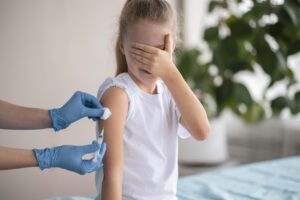Psychische Erkrankungen & Entwicklungsverzögerungen bei Kindern -und Jugendlichen
Mental health problems and developmental delays in children and adolescents are more widespread than the general public realise. In this article you can read up on the topic.
ImportantSelf-diagnosis can lead to incorrect treatment. Therapists and doctors have the Necessary training and experienceto diagnose and treat diseases. Therefore ALWAYS consult an appropriate expert in advance!
Table of contents
Psychische Erkrankungen bei Kindern- und Jugendlichen
Transcribed developmental disorders
Circumscribed developmental disorders (UES) are Impairments in certain areaswhich is already in the early development.
Special features:
- Isolated: The impairment is limited to one area, while other areas are normally developed.
- Intelligence: General intelligence is not affected.
Types of UES
- Language comprehension
- Language production
- Speech motor skills
- Reading and spelling disorder (LRS)
- Calculation disorder (dyscalculia)
- Gross motor skills (e.g. coordination)
- Fine motor skills (e.g. dexterity)
Disorders of social behaviour
Disorders of social behaviour describe a Patterns of dissocial, aggressive or rebellious behaviour.
- This pattern is repeated and/or persistent.
- It can lead to considerable impairments in social interaction and everyday life.
Emotional disorders of childhood
The emotional disorders of childhood primarily include anxiety disorders that occur in childhood. Essentially, these disorders are excessively pronounced normal development trends.
Main feature: Excessive fear of separation from important attachment figures
Symptoms:
- Clinging to attachment figures
- Refusal to stay alone
- Nightmares and sleep disorders
- Fear of school or kindergarten
- Somatic complaints such as abdominal pain or headaches
Main feature: Persistent and excessive fear of certain objects or situations
Typical phobias:
- Animal phobias (e.g. spiders, dogs)
- Nature phobias (e.g. thunderstorms, heights)
- Blood-injection injury phobia
- Situational phobias (e.g. school, enclosed spaces)
Main feature: Pronounced fear of social situations and interactions
Symptoms:
- Avoidance of new situations and people
- Shyness and restraint
- Fear of failure and embarrassment
Main feature: Excessive jealousy and conflicts between siblings
Symptoms:
- Disputes and aggression
- Verbal and physical attacks
- Feelings of shame and guilt
- Depressive moods
Supplementary clinical pictures
ADHD (attention deficit hyperactivity disorder)
ADHD is a neurological developmental disorder that probably genetic is.
Typical features of ADHD are:
- Inattention: Difficulty concentrating, completing tasks and following instructions.
- Hyperactivity: Restlessness, fidgeting, excessive talking and pacing.
- Impulsiveness: Difficulties in waiting, rethinking decisions and controlling actions.
Depression
Depression are not just an "adult disease". Children and adolescents can also suffer from depression.
Typical signs of depression:
- Persistent sadness
- Lack of drive and interest
- Social withdrawal
Eating disorders
Anorexia nervosa:
- Characteristics: Pathological desire for constant weight loss
- Symptoms: severely underweight, refusal to eat, distorted body image, fear of gaining weight
Bulimia (binge eating disorder):
- Characteristics: Recurrent binge eating followed by self-induced vomiting
- Symptoms: Normal weight or overweight, feeling of shame, depression, fear of gaining weight
Binge eating:
- Characteristics: Recurrent binge eating without compensatory behaviour (e.g. vomiting)
- Symptoms: Obesity, shame, depression, avoidance of social situations
Risk factors
A risk factor is a characteristic or trait that increases the risk of a person's Increased likelihood of developing a certain disorder. Compared to a group without this risk factor (unaffected control group), the risk for the affected group of people is therefore significantly higher.
There are Different types of risk factorsthat can increase the likelihood of a person developing problems.
- Individual risks (biological, genetic, acquired biological (e.g. due to injury) and ecological risks (e.g. due to environmental pollution))
- Psychological risks (impulsiveness, personality traits, etc.)
- Psychosocial risks (mental disorder of a parent, delinquency, financial problems, migration, family disputes; stressors in a broader sense)
Puberty
Puberty is a time of great change, both physically and mentally. During this vulnerable phase, there can be a mismatch between physical and psychological maturity. This mismatch, also known as "Maturation Mismatch Theory"can lead to a number of challenges that increase the risk of developing mental health problems.
Family influences
Family influences play an important role in the development of mental disorders in children and adolescents.
Parenting style:
- Inconsistent behaviour of the parents can lead to Delinquency (offences against the law) for the child.
- Overprotection and parental interference can emotional disorders such as separation anxiety.
Conflicts and stresses of the parents can have a particularly large influence on the Mental health of the child or adolescent.
Psychological or social abnormalities of a parent, such as Maternal depressionthe cognitive (spiritual) and social-emotional development negatively affect the child.
School system and pressure to perform
The high performance standards at school can have a considerable Burden for children and young people and as Risk factor for mental health problems such as burn-out.
The Bavarian Teachers' Association (BLLV) and Gymnasialeltern Bayern e. V. warn in a joint statement against the negative effects of:
- Curriculum printing
- Exam density
- High requirements
- Continuous performance assessment through examinations
These factors can severely affect students' mental health and lead to symptoms such as:
- Exhaustion
- Fear
- Depression
- Sleep disorders
- Concentration difficulties lead.
Internet use
The role of the media and social networks is much discussed in our society. Besides positive aspects such as information and education are also Negative influences on body image and self-esteem, especially among young people.
Causes are in favour of this:
- Comparison with unrealistic body images
- Feeling of constant pressure to be perfect
- Social isolation and bullying in online communities
Mental health problems in children and adolescents: Recognising signs and seeking help
Mental illnesses in children and adolescents are often difficult to recogniseas they are mainly located in the Interior and first play the Thinking and feeling before they have an impact on the Behaviour have.
Development-related Behavioural patterns in childhood and adolescence make identification even more difficult. Tantrums in early childhood or mood swings during puberty can be normal.
However, there are some symptoms that may indicate a mental illness and require immediate action:
- Strong fear
- Long-lasting sadness
- Inner restlessness
- Concentration problems
- Psychosomatic symptoms such as headaches or gastrointestinal complaints
Parents, teachers and other carers should be attentive and, if a mental illness is suspected Seek professional helpeven if the child or young person refuses.
Important:
- Do not hesitate to consult a doctor or psychologist.
- The earlier a mental illness is recognised, the better the chances of treatment.
Bibliography
Naab, S., Kunkel, J., Fumi, M., & Voderholzer, U. (2017). Psychosoziale Risikofaktoren für psychische Störungen im Jugendalter. Pädiatrie, 29(5), 24–32. https://doi.org/10.1007/s15014-017-0941-x
Achtung!Kinderseele. (o.D.). Thema: Psychische Erkrankungen. Abgerufen am 26. Februar 2024 von http://tinyurl.com/22gwe4ok
Bundeszentrale für gesundheitliche Aufklärung. (o.D.). Essstörungen. Abgerufen am 26. Februar 2024 von https://www.bzga-essstoerungen.de/
Emotionale Störung. (o.D.). Praxis Manfred Wurstner & Kollegen, Fachärzt für Kinder- und Jugendpsychiatrie, -psychotherapie. Abgerufen am 26. Februar 2024, von https://www.kinder-jugendpsychiater.org/diagnose/emotionale-stoerungen/
Schrör, S. (2021, August 17). Psychische Erkrankungen bei Kindern. NetDoktor. https://www.netdoktor.at/krankheiten/psychische-erkrankungen/bei-kindern/
Wewetzer, C. & Schneider, F. (2012). Mental illness in young patients. F, Schneider (Ed.), Facharztwissen Psychiatrie und Psychotherapie ( 1st edition, pp. 513-531). Springer.










